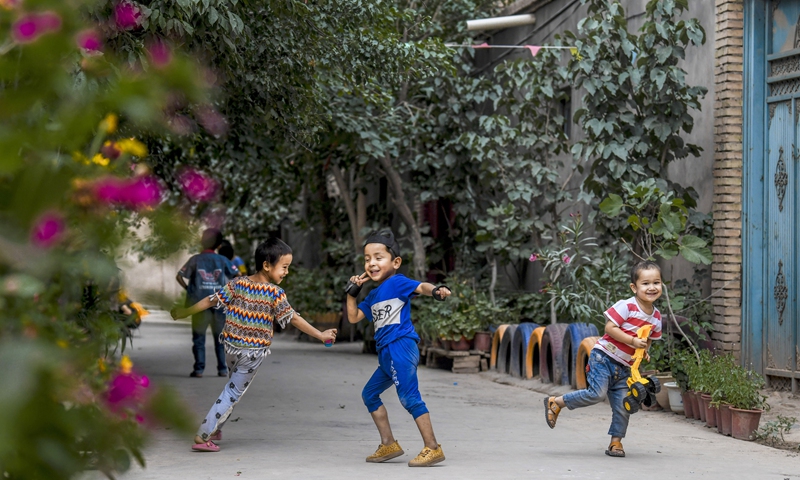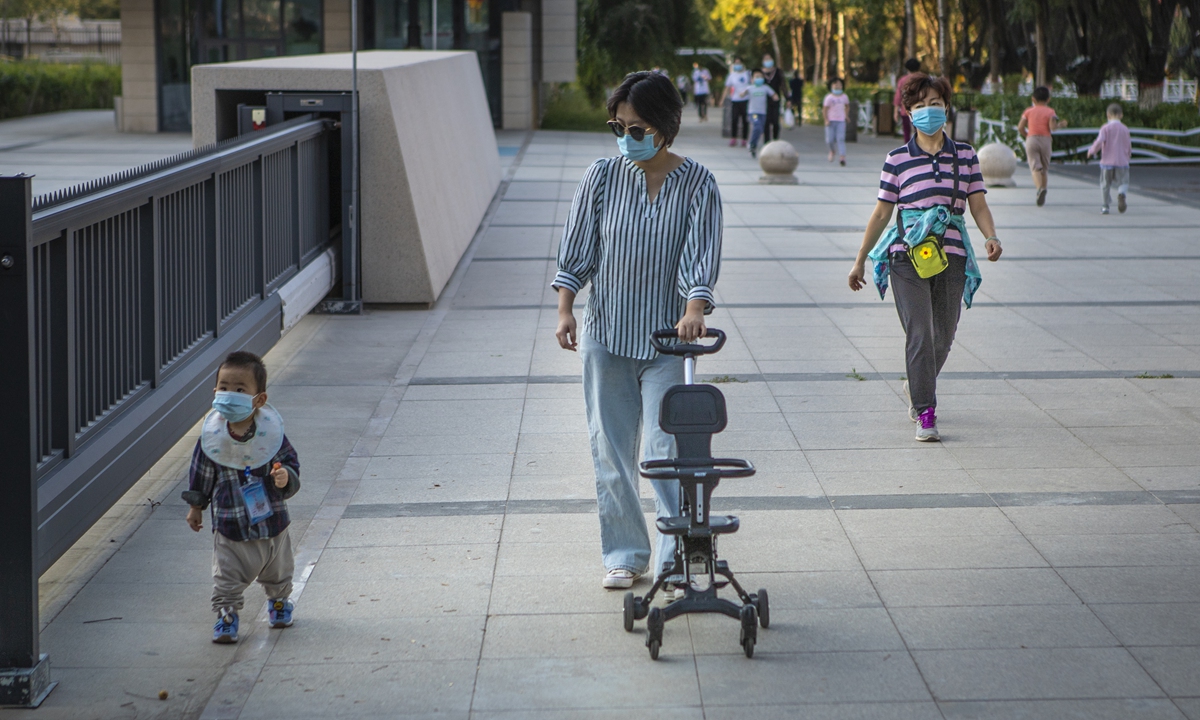
Children have fun in an alley at Qianjin Village in Kashgar, northwest China's Xinjiang Uygur Autonomous Region, Aug. 18, 2019. Photo:Xinhua
After being stuck in an Urumqi hotel for more than 40 days, Kurbanjan Samet can finally venture outside to local residential communities to shoot his new documentary on the prevention work of the novel coronavirus around the city. "More cars can be seen in the streets and more people are going outside to enjoy the sunshine… everything is getting back to normal and even better," Kurbanjan said on Wednesday after Xinjiang Uygur Autonomous Region
announced on Tuesday night to fully restore normal daily activities.
Before the
new outbreak of coronavirus hit Urumqi in July, Kurbanjan and his team were busy making a documentary on local cuisine in Xinjiang. However, as the city was put under a lockdown in the middle of July to fight against the virus, Kurbanjan and his workmates turned the camera toward local residents and volunteers to record their efforts in fighting the viral battle.
"The residential community where I am standing now is in the Tianshan district which reported infections. Many residents did not dare to go downstairs when strict home quarantine had been lifted at the end of August. In the past two days, I have heard a staff member from the residential community shouted downstairs to residents' windows, calling for them to go outside for a walk," Kurbanjan told the Global Times.
Many residents in Urumqi seemed to have reached their limits staying indoors and due to the long-time isolation at home, the city witnessed an outburst of frustration and worries from local residents on social media.
After hearing news on Tuesday night that Xinjiang announced to restore normal activities, Yiyi, a Urumqi resident living in the Tianshan district, contacted immediately her residential community staff and asked for information on when she can go back to the hospital where she works.
"I am sick of sitting inside my house and I am also worried about my apartment loan," she said.
Yiyi finally got a pass for her to leave the residential community and resumed her work on Wednesday. She also took videos on her way to the hospital showing that more cars are driving on the streets, children holding their parents' hands in the streets, and a sanitation worker sitting in front of a closed shop chatting with a pedestrian.
Life seems to be getting back on track but with something a little different than before - all passers-by were wearing masks, no salespeople were soliciting customers outside shops, hardly any horns were heard indicating traffic jams, many naan (oven-fresh steamed bread) stalls remain closed and people were lining up in front of a hospital waiting for nucleic tests before going outside of the city.
"It takes time" and "everything will get better gradually" These are the words that have been frequently heard and told in Urumqi and other places in Xinjiang in recent days as residents need time to get used to post-lockdown life and the whole of society and businesses also need time to recover from the pause.
Before the Party Committee of the Xinjiang region
announced on Tuesday night to return to normality while not relaxing epidemic prevention and control measures, Urumqi and many places in Xinjiang had already resumed work.
Transportation services in Urumqi, and Xinjiang broadly, are reopening. Since August 29, 30 percent of bus service in Urumqi has been resumed with strict disinfection requirements. But as of press time on Wednesday, the metro service in Urumqi, which paused since July 16 night, has not reopened.
The Global Times learnt that intercity bus service within Xinjiang departing from Urumqi is not available as of press time. But residents can take flight from Urumqi to other cities in Xinjiang.
Flights arriving in and departing from Xinjiang have also been partially resumed. Starting from the end of August, Urumqi International Airport has seen flights departing for Beijing, Qingdao in Shandong Province and other domestic cities. The Global Times learnt from airliners and relevant departments that passengers coming to Urumqi also need a negative nucleic acid test, a green health code and may face a 14-day quarantine upon arrival.
Aside from transportation, it also takes time for businesses and residents' daily lives to get back to normal. For example, many restaurants and entertainment venues remain closed. Students attending middle schools and primary schools in Urumqi and other places in Xinjiang began online classes on September 1.

After pressing the "pause button" for more than 45 days, Northwest China's Xinjiang Uygur Autonomous Region has restarted. Thanks to the residents' cooperation, the COVID-19 outbreak has been brought under control. The photo shows residents in Urumqi enjoying the outdoors. Photo: VCG
Lessons to be learned Experts said that Xinjiang needs to learn from experience in dealing with the outbreak, including adjusting a one-size-fit-all approach in grassroots management and better prepared for a possible new outbreak in the winter.
This wave of the epidemic in Xinjiang reminds us of the importance of not relaxing epidemic prevention and control measures. Even though Xinjiang has reopened its gates, the epidemic preventive measures cannot finish as the pandemic continues to wreak havoc around the world and a new outbreak may loom as winter is coming," Zhang Yuexin, a medical expert who is a part of Xinjiang's anti-epidemic group, told the Global Times on Wednesday.
Zhang noted that as the recently-concluded spike originated from clustered infections in a wedding being attended by hundreds of people in Urumqi, cluster activities should not be permitted and keeping social distance and wearing masks should be the top priorities for Xinjiang to prevent a new epidemic outbreak.
Detecting infections at an early stage and conducting thorough epidemiological investigations are also lessons the region can learn.
Borrowing experiences from other cities such as Beijing, Urumqi will also have to adopt a more effective way to contain the epidemic, that is, when there is an epidemic, locating patients and their close contacts as soon as possible and restricting small scale public activities in affected areas should be a priority, rather than locking down the entire city and grounding all economic activities to a halt, Zhang said.
To prevent COVID-19 resurgence in winter, when the cold and flu are also more common, hospitals in Urumqi are strengthening their efforts to manage fever clinics and screen COVID-19 patients.
As of press time on Wednesday, there have been no new cases of COVID-19 reported for 17 consecutive days. The hard-won achievements are all attributed to the people of Xinjiang.
"It is normal to hear some complaints from local people when strict prevention measures are being implemented. But more people showed their understanding as the government is giving priority to protecting people's lives and volunteers have made great efforts in helping people," Kurbanjan said, noting that some Xinjiang residents turned to social media platforms to complain.
As for some Western media which hyped up the region's prevention measures and attacked Xinjiang, Kurbanjan said that Xinjiang's people made complaints in hopes that the region would become better, but those negative media outlets only want to slander the region with lies.
On Wednesday, many residents in Xinjiang posted pictures of their first day at work on social media with many expressing happiness to be back to normal life and wishes for a better tomorrow for the region after a tough viral battle.





